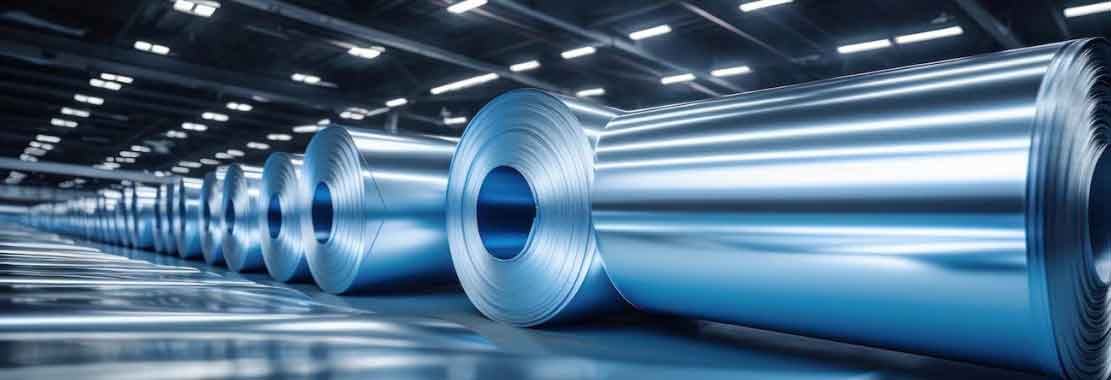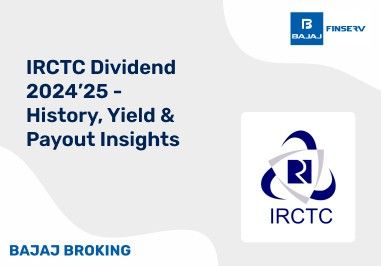Introduction
The strength of India's metal sector is evident from the impressive growth of the Nifty Metal index, which has seen double-digit gains in the past two years. This growth underscores the sector's crucial role in the country's economic development, fuelled by increasing demand, infrastructure projects, and government initiatives. In this blog, we delve into the key factors affecting metal stocks in India, including global market trends, local policies, and industry dynamics. Additionally, we highlight the top metal stocks by market capitalisation, offering valuable insights for investors. Whether you're an experienced investor or new to the market, understanding these factors will help you make informed decisions. To get started, opening a trading account is essential for seamless transactions in the stock market.
What are Metal Stocks?
Metal stocks refer to shares of companies involved in the extraction, production, and processing of metals like steel, aluminium, copper, and zinc. These companies play a vital role in industries such as construction, manufacturing, and infrastructure development. The value of metal stocks is largely influenced by fluctuations in metal prices, global demand, and economic conditions. As industrial activity and technological advancements drive metal demand, investors must monitor these factors to assess the potential growth and profitability of metal companies. To invest in metal stocks, one needs a Demat account, which facilitates the electronic storage and transfer of securities, making trading seamless and efficient.
Metal Industry in India
The metal industry in India plays a vital role in the nation's economy, contributing to growth, employment, and exports. Key highlights include:
- India is the world’s second-largest producer of crude steel and aluminium and the fourth-largest producer of iron ore.
- The country boasts large reserves of iron ore, bauxite, chromium, manganese ore, and other key minerals.
- The sector is expected to grow due to initiatives like Make in India, Smart Cities, Rural Electrification, and the National Electricity Policy.
- The metal industry creates jobs and supports the manufacturing and construction sectors.
- India’s exports of metals boost foreign exchange reserves.
- The metal industry has a rich history, with the first iron and steel plant, Tata Iron and Steel Company (TISCO), established in 1907.
- Recent developments include the inauguration of India's first Green Hydrogen Plant in March 2024 at Jindal Stainless Limited in Hisar.
- Investors can look out for potential growth, including upcoming IPOs in the metal sector.
What are the Features of Metal Stocks in India?
The features of metal stocks in India reflect the dynamics of the metal industry, which is influenced by global and local factors:
- Market Sensitivity: Metal stocks are influenced by global economic conditions and fluctuations in commodity prices.
- Global Trade Impact: International trade policies, tariffs, and economic growth can significantly affect stock performance.
- Price Volatility: Metal stock prices experience high volatility due to supply-demand dynamics in the global markets.
- Capital Requirements: The metal sector requires large capital investment in mining, infrastructure, and technology, impacting financial stability.
- Environmental Compliance: Companies in the metal industry must comply with strict environmental and safety regulations.
- Risk Diversification: Metal companies typically deal in various metals, such as iron, aluminium, and zinc, which helps spread risk.
Top Metal Stocks in India as per Market Cap*
Company
| CMP (₹)
| Market Cap (₹ m)
| P/E (x)
| RoE (Latest, %)
| D/E (Curr FY, x)
| Sales CAGR (3 yrs, %)
| Profit CAGR (3 yrs, %)
|
JSW Steel
| 999.9
| 2,445,087
| 46.7
| 11.6%
| 1.1
| 29.9%
| 4.5%
|
Hindalco
| 670.3
| 1,506,204
| 12.1
| 9.5%
| 0.6
| 17.8%
| 25.1%
|
Jindal Steel & Power
| 994.6
| 1,014,529
| 20.1
| 13.4%
| 0.4
| 6.1%
| 2.5%
|
SAIL
| 126.9
| 524,164
| 26.4
| 5.4%
| 0.6
| 15.1%
| NM
|
NALCO
| 249.6
| 458,423
| 14.5
| 13.8%
| 0.0
| 13.7%
| 15.2%
|
*Note: CMP (₹): Current Market Price; Market Cap (₹ m): Market Capitalisation; P/E (x): Price-to-Earnings ratio, RoE (Latest, %): Return on Equity percentage; D/E (Curr FY, x): Debt-to-Equity ratio; Sales CAGR (3 yrs, %): Compound annual growth rate of sales over three years; Profit CAGR (3 yrs, %): Profit growth over three years; NM indicates not meaningful.
The table highlights the top metal stocks in India by market capitalisation as of 11th December 2024. It provides a comprehensive overview of the leading companies in the metal sector, covering key financial metrics such as the P/E ratio, quarterly profit, profit variance, quarterly sales, and return on capital employed (ROCE). These metrics offer a snapshot of each company's financial performance, market standing, and growth prospects. For those interested in intraday trading, having the right tools and strategies can enhance the potential for quick profits in the stock market.
- JSW Steel: Market cap of ₹2,44,582.23 crore, P/E ratio of 47.64, quarterly profit of ₹404 crore, and quarterly sales of ₹39,684 crore. ROCE stands at 13.30%.
- Hindalco Industries: Market cap of ₹1,50,687.80 crore, P/E ratio of 11.54, quarterly profit of ₹3,909 crore, with quarterly sales of ₹58,203 crore and an ROCE of 11.29%.
- Jindal Steel & Power: Market cap of ₹1,01,513.70 crore, P/E ratio of 20.06, quarterly profit of ₹860.47 crore, and quarterly sales of ₹11,213.31 crore. ROCE is 13.16%.
- SAIL (Steel Authority of India): Market cap of ₹52,420.48 crore, P/E ratio of 16.60, quarterly profit of ₹897.15 crore, and quarterly sales of ₹24,675.20 crore. ROCE stands at 8.10%.
- NALCO (National Aluminium): Market cap of ₹45,822.14 crore, P/E ratio of 16.07, quarterly profit of ₹1,062.18 crore, with quarterly sales of ₹4,001.48 crore and an impressive ROCE of 16.95%.
This data, sourced from Equitymaster, provides valuable insights into the financial health and market leadership of key players in India’s metal sector.
Overview of Metal Stocks in India
The Metals & Mining sector in India includes companies involved in extracting and producing essential metals such as steel, aluminium, zinc, and copper, which serve both domestic and export markets. With 211 companies and an average market capitalisation of ₹10,173 crore, the sector grew by 4.85% last quarter, outperforming the Nifty50, which dropped by 1.59%. The sector boasts a Sector Score of 57.2/100, alongside a Return on Equity (RoE) of 23.76% and a Return on Capital Employed (RoCE) of 24.34%, suggesting strong profitability. Although Net Profit Growth YoY is slightly negative at -2.94%, quarterly growth has surged by 75.15%, showing resilience and potential.
The Other Non-Ferrous Metals Industry, which includes companies producing lead, magnesium, and other alloys, has 8 firms with an average market capitalisation of ₹2,417 crore. Despite a slight decline of -2.08% over the last quarter, the industry’s RoE of 25.10% and Return on Assets (RoA) of 13.50% demonstrate solid financial health. Quarterly YoY growth of 33.26% indicates strong momentum in the sector. This data is sourced from Trendlyne.
Overview of JSW Steel
- Core Business: JSW Steel manufactures and sells iron and steel products, with a diversified portfolio including hot-rolled, cold-rolled, galvanised, pre-painted, and special steel products.
- Flagship Company: It is the flagship business of the JSW Group, a diversified conglomerate with interests in energy, infrastructure, cement, paints, sports, and venture capital.
- Revenue Breakdown (Q3FY24):
- Retail: 33%
- Auto: 14%
- Industrial: 16%
- Construction & Infra: 37%
- Geographic Reach: 93% of revenue comes from the domestic market, with 7% from exports.
- Value-Added Steel Products: The share of revenue from value-added steel products (VASP) has increased from 35% in FY16 to 60% in Q3FY24, with a target of maintaining over 50% in the future.
- Capacity Utilisation: The company has an average India capacity utilisation of 94%.
- Distribution Network (Q3FY24):
- Present in ~17,500 retail stores across 530+ districts.
- Strong network with 2,475 points, including 450 distributors and 2,025 branded stores.
- Manufacturing Capacity: As of Q3FY24, JSW Steel has a total capacity of 28.2 million tonnes per annum (Mt), with major plants in Vijayanagar, BPSL, and JISPL.
- Expansion Plans: The company aims to expand capacity to 37 Mt by FY25-26 and 50 Mt by FY30 through brownfield and greenfield expansions.
- JSW One: Launched JSW One TMT in Nov’23, an integrated B2B commerce platform for MSMEs with ~43,000 registered users and an annual GMV of ₹6,800 crore+.
- NCDs: Plans to issue ₹2,000 crore in secured/unsecured, redeemable non-convertible debentures in Jan’24.
- Growth Focus: Aims to increase JSW Steel India's capacity to 37 Mt by FY25-26, with long-term growth plans for 50 Mt by FY30.
JSW Steel Financial Snapshot*
Name
| CMP Rs.
| P/E
| Mar Cap Rs.Cr.
| Div Yld %
| NP Qtr Rs.Cr.
| Qtr Profit Var %
| Sales Qtr Rs.Cr.
| Qtr Sales Var %
| ROCE %
|
JSW Steel
| 1000.20
| 47.64
| 244582.23
| 0.73
| 404.00
| -76.10
| 39684.00
| -10.99
| 13.30
|
*Note: CMP – Current Market Price; P/E – Price to Earnings Ratio; Mar Cap – Market Capitalisation; Div Yld – Dividend Yield; NP Qtr – Net Profit for the Quarter; Qtr Profit Var – Quarterly Profit Variation; Sales Qtr – Sales for the Quarter; Qtr Sales Var – Quarterly Sales Variation; ROCE – Return on Capital Employed.
Overview of Hindalco Industries
- Incorporation: Established in 1958, Hindalco is the flagship company of the Aditya Birla Group and a leading producer of aluminium and copper.
- Business Segments:
- Aluminium: Among the top five global aluminium producers, Hindalco has an integrated low-cost aluminium production system.
- Copper: Operates one of the world's largest single-location copper smelters and produces copper cathodes and rods.
- Chemicals: Manufactures calcined alumina and alumina hydrates for various industrial applications.
- Market Leadership: Hindalco is the world’s largest aluminium rolling and recycling company, and the largest flat rolled aluminium producer globally, as well as the largest downstream aluminium player in India.
- Revenue Split (FY22):
- Aluminium: 16%
- Copper: 19%
- Novelis (subsidiary): 65%
- Geographical Revenue Split (FY22):
- India: 24%
- Outside India: 76%
- Novelis: A subsidiary that produces automotive and beverage can sheets with an integrated network of advanced facilities across North America, South America, Europe, and Asia.
- Manufacturing Capabilities: Hindalco has 50 manufacturing units across 10 countries, including 17 units in India, 19 bauxite mines, and 33 overseas units of Novelis.
- Production Capacity: Includes alumina (3.6 million MT), primary aluminium (1.3 million MT), copper cathodes (0.4 million MT), and Novelis rolling (4 million MT) and recycling (2.5 million MT).
- Expansion: Ongoing capacity expansions in alumina, copper, and flat rolled products (FRP), including a significant investment in the US, China, and Europe.
- Investments: Hindalco is investing $3.0–3.3 billion in India’s aluminium, copper, and specialty alumina sectors, with an additional $4.5 billion planned for Novelis facilities.
- Renewable Energy Target: Aiming for a renewable capacity of 300 MW by FY2024-25, including solar power with hybrid storage.
- Focus: Continues to prioritise expanding downstream capacities, especially in flat rolled products, extrusions, and other aluminium products.
Hindalco Industries Financial Snapshot*
Name
| CMP Rs.
| P/E
| Mar Cap Rs.Cr.
| Div Yld %
| NP Qtr Rs.Cr.
| Qtr Profit Var %
| Sales Qtr Rs.Cr.
| Qtr Sales Var %
| ROCE %
|
Hindalco Inds.
| 670.50
| 11.54
| 150687.80
| 0.52
| 3909.00
| 96.22
| 58203.00
| 7.45
| 11.29
|
*Note: CMP – Current Market Price; P/E – Price to Earnings Ratio; Mar Cap – Market Capitalisation; Div Yld – Dividend Yield; NP Qtr – Net Profit for the Quarter; Qtr Profit Var – Quarterly Profit Variation; Sales Qtr – Sales for the Quarter; Qtr Sales Var – Quarterly Sales Variation; ROCE – Return on Capital Employed.
Overview of Jindal Steel & Power
- Industry Presence: One of India’s leading steel producers with a strong presence in mining and power generation, operating globally across several countries including Australia, Botswana, and South Africa.
- Product Portfolio: Offers a range of steel products such as plates & coils, wire rods, TMT rebar, track rails, and structural steel products including beams, columns, channels, and angles.
- Steel Production & Sales: Steel production in H1 FY25 was 4.02 million tonnes, while steel sales were 3.95 million tonnes, reflecting a decrease from previous years (FY24: 7.92 million tonnes, FY22: 8.01 million tonnes).
- Revenue Mix:
- Geography-wise: 91% from domestic sales, 9% from exports (Q2 FY25).
- Sector-wise (Q2 FY25): Infrastructure (40%), Distribution (31%), Building & Construction (15%), Engineering & Packaging (10%), Automotive (3%).
- Value-Added Products: Revenue from value-added products grew to 64% in FY24, driven by specialised grades for high-growth sectors like shipbuilding, renewables, and defence.
- Retail Network: Distributed through 47 distributors, 6 yards, 4,350 dealers, 19 experience centres, and 34,000 influencers across 9 high-growth states.
- Manufacturing Facilities: Operates 4 manufacturing units with a total capacity of 10.42 MTPA for iron making, 9.6 MTPA for liquid steel, and 7.25 MTPA for finished steel.
- Capacity Expansion: Expanding steel capacities to 16.82 MTPA for iron making, 15.9 MTPA for liquid steel, and 13.75 MTPA for finished steel, with a Rs. 31,000 Cr capex plan.
- Raw Material Integration: Holds coking coal mining assets in Australia, Mozambique, and South Africa, with a focus on reducing reliance on Australian coking coal by 50% through new supplies.
- Renewable Energy Project: Aiming to invest in green hydrogen production for steelmaking in Angul, with a capacity of 4,500 TPA by December 2025.
- Debt Management: Net debt increased to Rs. 12,464 Cr in Q2 FY25, with plans to fund part of the expansion via internal accruals and maintain an optimal debt-to-EBITDA ratio.
- Focus: Aims to focus on value-added products for better margins and improving realisations while reducing leverage.
Jindal Steel & Power Financial Snapshot*
Name
| CMP Rs.
| P/E
| Mar Cap Rs.Cr.
| Div Yld %
| NP Qtr Rs.Cr.
| Qtr Profit Var %
| Sales Qtr Rs.Cr.
| Qtr Sales Var %
| ROCE %
|
Jindal Steel
| 994.65
| 20.06
| 101513.70
| 0.20
| 860.47
| -38.00
| 11213.31
| -8.46
| 13.16
|
*Note: CMP – Current Market Price; P/E – Price to Earnings Ratio; Mar Cap – Market Capitalisation; Div Yld – Dividend Yield; NP Qtr – Net Profit for the Quarter; Qtr Profit Var – Quarterly Profit Variation; Sales Qtr – Sales for the Quarter; Qtr Sales Var – Quarterly Sales Variation; ROCE – Return on Capital Employed.
Overview of Steel Authority of India Ltd (SAIL)
- Overview: A state-owned steel producer with a 65% government stake (as of June 2024), SAIL is one of India’s largest steel companies and holds Maharatna status.
- Product Offerings: SAIL is an integrated producer of iron and steel, offering a range of products for sectors such as construction, engineering, power, railways, automotive, and defence. Products include flat, long, and semi-finished steel items, with over 50 products including brands like SAIL SeQR and NEX.
- Steel for Railway: Fulfils all steel track demands of Indian Railways, supplying 11.5 lakh tonnes of rails in FY24.
- Product Mix (FY24): HR Plates/Coils/Sheets (27%), Bars & Rods (22%), PM Plates (14%), Structurals (9%), Semis (8%), Railway Products (8%), Others (12%).
- Volume (FY24): Crude Steel Production – 19.2 million tonnes, Saleable Steel Production – 18.4 million tonnes, Sales Volume – 17 million tonnes.
- Value-Added Products: Introduced 25 new value-added products in FY24. The share of value-added products in total revenue increased from 51% in FY22 to 53% in FY24.
- Operational Performance: Sales volumes grew by 5% from FY22 to FY24, but revenue increased by only 2%, with a 3% reduction in sales realisations.
- Geographical Split (FY24): Domestic – 98%, Exports – 2%.
- Clientele: Supplied steel for major projects such as Bengaluru Metro, Chennai Metro, Kalpakkam Nuclear Project, and Mumbai Trans Harbour Link.
- Distribution Network: A network of approximately 5,200 dealers and distributors, with 41 new distributors added in FY24.
- Raw Material: Met the total iron ore requirement from captive sources, producing 34.34 million tonnes in FY24. Indigenous sources met 2.45 million tonnes of coking coal out of 19.37 million tonnes consumed.
- Production Capabilities: Operates 5 integrated steel plants and 3 special steel plants, with a total crude steel capacity of 19.63 MTPA and saleable steel capacity of 18.54 MTPA.
- Capacity Utilisation: Crude steel capacity utilisation in FY24 was 98%, up from 89% in FY22. Saleable steel capacity utilisation was 99%, up from 86% in FY22.
- Expansion: Plans to increase capacity to 35 MTPA by FY31-FY32, with a Rs. 1,00,000 Cr investment, 50% of which will be funded by debt. The projected capex for FY25 is Rs. 6,300 Cr.
- Debt: Total debt increased from Rs. 17,284 Cr in FY22 to Rs. 36,323 Cr in FY24, primarily due to higher working capital needs.
- Focus: Aims for crude steel production of 20.87 million tonnes and sales volume of 19.26 million tonnes in FY25, with a focus on improving production efficiencies at Integrated Steel Plants.
SAIL Financial Snapshot*
Name
| CMP Rs.
| P/E
| Mar Cap Rs.Cr.
| Div Yld %
| NP Qtr Rs.Cr.
| Qtr Profit Var %
| Sales Qtr Rs.Cr.
| Qtr Sales Var %
| ROCE %
|
SAIL
| 126.95
| 16.60
| 52420.48
| 1.58
| 897.15
| -44.34
| 24675.20
| -16.95
| 8.10
|
*Note: CMP – Current Market Price; P/E – Price to Earnings Ratio; Mar Cap – Market Capitalisation; Div Yld – Dividend Yield; NP Qtr – Net Profit for the Quarter; Qtr Profit Var – Quarterly Profit Variation; Sales Qtr – Sales for the Quarter; Qtr Sales Var – Quarterly Sales Variation; ROCE – Return on Capital Employed.
Overview of National Aluminium Company Ltd (NALCO)
- Overview: Incorporated in 1981, NALCO is a Navratna public sector enterprise under the Ministry of Mines, and one of the largest integrated Bauxite-Alumina-Aluminium-Power complexes in India and Asia.
- Product Segments:
- Aluminium (73% of FY24 revenue): Includes aluminium ingots, wire rods, billets, and rolled products. The sale volume of aluminium increased by 3% from FY22 to FY24, although average sales realisation declined by 8%.
- Chemicals (27% of FY24 revenue): Includes Calcined Alumina, Alumina Hydrate, and related products. Alumina sale volume decreased by 5% from FY22 to FY24.
- Margin Decline: Operating profit margins fell from 32% in FY22 to 22% in FY24, driven by a 42% increase in raw material costs and a 5% rise in power and fuel expenses.
- Geographical Split: Domestic sales accounted for 67% in FY24 (up from 56% in FY22), while exports decreased to 33% (from 44% in FY22).
- Raw Material Availability: NALCO has operationalised its Utkal-D and Utkal-E coal mines and a Caustic Soda plant in Gujarat, which helped reduce reliance on costly e-auction coal.
- Manufacturing Capacity & FY24 Utilisation:
- Alumina Refinery: 22.75 Lakh MTPA, with 93% utilisation.
- Aluminium Smelter: 4.6 Lakh MTPA, with 100% utilisation.
- Bauxite Mine: 68.25 Lakh MTPA, with 110% utilisation.
- Thermal Power Plant: 1,200 MW and Wind Power Plant: 198.4 MW.
- Expansion Projects: NALCO is investing ₹8,254 Cr in a fifth alumina refinery stream and the Pottangi Bauxite mines, with plans to expand alumina refining capacity to 31 Lakh MTPA by 2025. A smelter expansion of 5 Lakh MTPA is underway with a ₹17,000 Cr investment.
- Alternative Sourcing: The company is sourcing bauxite from Pottangi and Panchpatmali Mines South Block, with a new crushing and conveying system under development for ₹483 Cr, set for completion by May 2025.
- MoUs & Strategic Alliances: NALCO has signed an agreement with Argentina’s CAMYEN S.E. for lithium mine exploration and development, and MoUs with CSIR-NGRI and CSIR-IMMT for collaboration in critical minerals.
- Focus: NALCO is focused on expanding its core business, forward integration, downstream facilities, and ensuring raw material security, with a long-term strategy to boost revenue and profitability.
NALCO Financial Snapshot*
Name
| CMP Rs.
| P/E
| Mar Cap Rs.Cr.
| Div Yld %
| NP Qtr Rs.Cr.
| Qtr Profit Var %
| Sales Qtr Rs.Cr.
| Qtr Sales Var %
| ROCE %
|
Natl. Aluminium
| 249.53
| 16.07
| 45822.14
| 2.00
| 1062.18
| 414.97
| 4001.48
| 31.48
| 16.95
|
*Note: CMP – Current Market Price; P/E – Price to Earnings Ratio; Mar Cap – Market Capitalisation; Div Yld – Dividend Yield; NP Qtr – Net Profit for the Quarter; Qtr Profit Var – Quarterly Profit Variation; Sales Qtr – Sales for the Quarter; Qtr Sales Var – Quarterly Sales Variation; ROCE – Return on Capital Employed.
What Factors Should One Consider Before Investing in Metal Sector Stocks in India?
Before investing in metal sector stocks in India, consider the following factors:
- Stock Trend Indicators: Review moving averages, support, and resistance levels to gauge market trends for metal stocks.
- Government Regulation Impact: Keep an eye on policy changes, including customs duties and export incentives, that could affect metal prices.
- Financial Stability Check: Assess key financial metrics, such as balance sheets and cash flow, to understand the health of companies.
- Raw Material Availability and Prices: Monitor the supply and cost of raw materials, which are crucial to company performance and stock valuations.
- Macroeconomic Factors: Track inflation, interest rates, and political stability, as these elements can influence metal stock performance.
- Global Market Influences: Stay informed about global metal trends, as international prices can significantly impact Indian metal stocks.
What Factors Influence the Performance of Metal Stocks?
Several factors shape the performance of metal stocks in India, including the following:
- Global Metal Demand: Increased demand for metals worldwide, driven by infrastructure development and industrial growth, positively impacts Indian metal companies.
- Economic Revival: Post-pandemic economic recovery spurred demand in key sectors like construction and manufacturing, driving up metal consumption.
- Government Initiatives: Initiatives like 'Make in India' and 'Aatmanirbhar Bharat' encourage domestic production, benefiting the metal sector.
- Infrastructure Projects: The government's push for infrastructure development, such as highways and smart cities, creates significant demand for metals.
- Supply Chain Shifts: Disruptions in global supply chains have prompted a focus on local metal production, strengthening domestic industries.
- Technological Innovation: Advancements in metal production technology improve efficiency and lower costs, enhancing global competitiveness.
- Sustainability Trends: Growing emphasis on eco-friendly practices influences investment in metal companies adopting sustainable methods.
- Strong Financials: Healthy financial performance and solid growth prospects attract investors to leading metal companies.
How to pick Metal stocks?
Choosing the right metal stocks involves considering these key strategies:
- Effective Portfolio Diversification: Invest in a variety of metal stocks, including those in steel, aluminium, copper, and more, to spread the risk.
- Conduct In-depth Research: Assess the financial health, leadership, and growth potential of companies to make informed choices.
- Think Long-term: Metal stocks are cyclical, so consider holding them as part of a long-term strategy rather than focusing on short-term profits.
- Track Global Developments: Stay updated on global metal demand and trends, as they can directly influence Indian metal stocks.
- Sustainable Investing: Look for companies with a strong environmental focus, as they may offer greater resilience and growth opportunities.
- Seek Professional Advice: Consult a financial advisor to gain insights tailored to your investment goals.
Why Invest in Metal Stocks?
Investing in metal stocks in India offers several opportunities due to the country's expanding economy and strong domestic market:
- Infrastructure Expansion: India’s infrastructure boom, including projects like smart cities and transport networks, is a major driver of demand for metals such as steel and copper.
- Robust Economic Growth: The country’s rapid economic development fuels the need for metals in various sectors, enhancing the demand for materials like aluminium and zinc.
- Export Opportunities: Indian metal companies benefit from cost competitiveness, securing a significant share of the export market.
- Favourable Government Policies: Initiatives like "Make in India" and pro-manufacturing policies bolster the growth of the metal sector.
- Attractive Dividends: Established metal companies often provide attractive dividend yields, offering a reliable income stream for investors.
Should You Invest in Metal Stocks?
Investing in metal stocks can be a smart choice for those seeking portfolio diversification and exposure to sectors linked to economic growth and infrastructure development. However, the metal sector is highly volatile and cyclical, influenced by global market conditions and commodity price fluctuations. As such, it's important to assess your risk tolerance and investment goals before committing to metal stocks. Understanding the market trends and consulting a financial advisor can help ensure these investments align with your broader financial strategy. Ultimately, metal stocks can offer significant growth potential, but caution is needed due to their inherent risks.
What are the advantages of investing in Metal Stocks in India?
Investing in metal stocks in India offers several advantages:
- Strong Return Potential: Metal stocks can yield significant returns, particularly when metal prices rise or economic growth accelerates.
- Portfolio Diversification: These stocks provide diversification, reducing risk by including assets that react differently from sectors like technology or finance.
- Inflation Hedge: Metals, such as gold and steel, often perform well during inflationary periods, helping to protect investment value.
- Exposure to Economic Expansion: Metal companies are closely tied to infrastructure and industrial development, providing a chance to profit from India’s growing economy and government initiatives like “Make in India”.
Who Can Invest in Metal Stocks?
Investing in metal stocks in India may be suitable for:
- Risk-Tolerant Investors: Those willing to navigate market volatility for the potential of high returns during periods of rising metal prices and economic growth.
- Growth-Seeking Individuals: Investors aiming to capitalise on economic expansion and infrastructure development.
- Portfolio Diversifiers: Those looking to diversify their investments with exposure to the industrial and commodity sectors.
- Inflation Hedge Seekers: Individuals who want to protect their portfolio against inflation by investing in assets that typically appreciate during inflationary periods.
Is Investing in Metal Stocks risky?
Yes, investing in metal stocks carries certain risks:
- Market Fluctuations: Metal prices can be volatile, influenced by global demand and supply, geopolitical events, and economic shifts, affecting stock performance.
- Economic Sensitivity: The sector is closely tied to economic cycles, with downturns reducing demand and profitability.
- Regulatory Risks: Stricter environmental and safety regulations can increase costs or disrupt operations.
- Global Competition: Indian metal companies face competition from international players, impacting market share and profitability.
- Currency Exchange Risks: Metal prices are often dollar-denominated, making fluctuations in the exchange rate a potential risk for Indian companies.
- Resource Depletion: Metal companies must invest in new resources, adding to operational costs and risks.
While potentially rewarding, these factors make investing in metal stocks inherently risky.
How To Invest In Metals Stocks?
To invest in metal stocks, follow these steps:
- Research Companies: Study the financial health, market position, and growth potential of metal companies.
- Choose Stocks with Strong Fundamentals: Focus on firms with solid performance and a good track record in the metal sector.
- Open a Brokerage Account: Use a reliable platform to buy shares of selected metal companies.
- Diversify Your Investments: Spread your investments across various metal sectors (e.g., steel, aluminium, copper) to reduce risk.
- Monitor Market Trends: Stay updated on global metal prices, economic indicators, and industry developments to make informed decisions.
By carefully selecting stocks and staying informed, you can manage risks and potentially gain from the growth of the metal industry.
What is the Impact of Government Policies on Metal Stocks?
Government policies play a crucial role in shaping the performance of metal stocks. Key impacts include:
- Regulations and Tariffs: Imposition of tariffs or trade restrictions can affect production costs and competition.
- Environmental Laws: Stringent environmental regulations can increase operational costs for metal companies.
- Favourable Policies: Incentives like tax benefits or infrastructure development plans can drive demand for metals, benefiting the sector.
- Subsidies: Government subsidies can reduce costs and improve profitability for metal companies.
Investors need to monitor government policy changes, as these can significantly influence metal prices, company performance, and stock values.
How Metal Stocks Perform in Economic Downturns?
During economic downturns, metal stocks generally underperform due to several factors:
- Reduced Demand: Lower industrial and construction activities lead to decreased demand for metals, impacting revenues.
- Falling Metal Prices: Economic slowdowns often result in lower metal prices, hurting company profits.
- Increased Volatility: Investor uncertainty can heighten volatility in metal stock prices.
- Profitability Struggles: Reduced demand can lead to thinner margins and operational difficulties for metal companies.
Investors should be cautious, as these factors can cause significant declines in the performance of metal stocks during economic downturns.
What is the GDP contribution of Metal Sector Stocks?
The metal sector plays a crucial role in contributing to GDP, especially through its impact on key industries:
- Industrial Growth: Metals are essential for manufacturing, construction, and infrastructure, driving economic expansion.
- Exports: High-value metal exports generate foreign exchange, contributing significantly to national revenue.
- Job Creation: The sector provides employment, stimulating economic activity and increasing overall GDP.
- Economic Diversification: The metal industry supports a variety of sectors, adding depth and resilience to the economy.
Overall, metal sector stocks are vital to the economic growth of both developing and developed nations, driving industrialisation and boosting export potential.
Conclusion
Metal stocks in India present a promising investment opportunity driven by factors like economic recovery, infrastructure growth, and export potential. The sector’s strong link to industrialisation and government initiatives further enhances its attractiveness. However, due diligence is essential before investing, as market volatility and sector-specific risks should be carefully evaluated. Aligning investments with your financial goals and risk tolerance is crucial. For those unsure, seeking advice from a financial advisor can help ensure informed, well-guided decisions. With the right strategy, investing in India's metal sector can yield significant long-term benefits.
Other Popular Metal Stocks in India
Some popular metal stocks in India include:
- Tata Steel: A leading player in the steel industry, known for its strong financial performance and global reach.
- Vedanta Limited: A diversified natural resources company involved in the mining of metals like zinc, copper, and aluminium.
- Bhushan Steel: A major player in the steel manufacturing sector, catering to both domestic and international markets.
- Adani Enterprises: A conglomerate involved in various sectors, including metal mining and production.
- Hindustan Zinc: A key zinc producer, known for its strong financial performance and growth prospects.
Do you have a trading account app or demat account app?
You can open an account with Bajaj Broking in minutes.
Download the Bajaj Broking app now from Play Store or App Store.
Disclaimer: Investments in the securities market are subject to market risk, read all related documents carefully before investing.
This content is for educational purposes only. Securities quoted are exemplary and not recommendatory.
For All Disclaimers Click Here: https://bit.ly/3Tcsfuc














